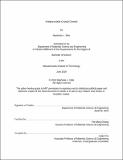Antiperovskite crystal growth
Author(s)
Eiler, Stephanie L.
Download1117775531-MIT.pdf (1.812Mb)
Other Contributors
Massachusetts Institute of Technology. Department of Materials Science and Engineering.
Advisor
Yet-Ming Chiang.
Terms of use
Metadata
Show full item recordAbstract
Research towards the implementation of solid state electrolyte in lithium ion batteries is necessary to increase the energy density of such devices. This technology is imperative for the adoption of sustainable technology such as electric vehicles. The study of antiperovskites is vital for success of solid state electrolyte. Antiperovskites have been shown to have high ionic conductivities in literature, making it an attractive area of study. Single crystals of this structure are necessary to fully identify the mechanism of ion conduction in antiperovskite. X-ray photon correlation spectroscopy on a single crystal would provide clear data that could help determine the mobility of various defects through the antiperovskite lattice. Characterization of defect mobility would allow for the better design of antiperovskites as a solid state electrolyte by providing parameters for how the material can be altered for higher ionic conductivity. Experiments show that Li₂OHCl is an antiperovskite possibly capable of congruent melting, making it a possible candidate for single crystal growth through the Bridgman method. With this rational, the PARADIM Bulk Crystal Growth Facilities at Johns Hopkins University were utilized to attempt this type of crystal growth. Additional crystal growth experiments were conducted by simply slowly cooling the material in box furnaces with the notion that this would promote large grain growth. Samples created using these methods were examined using optical microscopy and Laue diffraction. Crystals grown in PARADIM Bridgman furnaces were shown to have some grains that are roughly two mm across. From these attempts at crystal growth, recommendations for improved Li₂OHCl crystal growth have been identified. Phase transformations in the material presented clear challenges in crystal growth by offering an opportunity for twinning to occur in the crystal as it cooled. In addition to this, the volume change during solidification and the thermal coefficient of expansion was such that very slow cooling rates would be necessary for single crystal growth.
Description
This electronic version was submitted by the student author. The certified thesis is available in the Institute Archives and Special Collections. Thesis: S.B., Massachusetts Institute of Technology, Department of Materials Science and Engineering, 2019 Cataloged from student-submitted PDF version of thesis. Includes bibliographical references (pages 45-46).
Date issued
2019Department
Massachusetts Institute of Technology. Department of Materials Science and EngineeringPublisher
Massachusetts Institute of Technology
Keywords
Materials Science and Engineering.